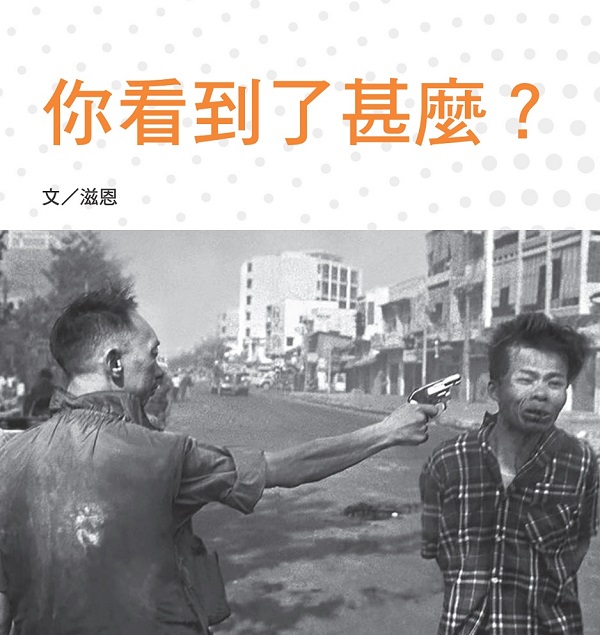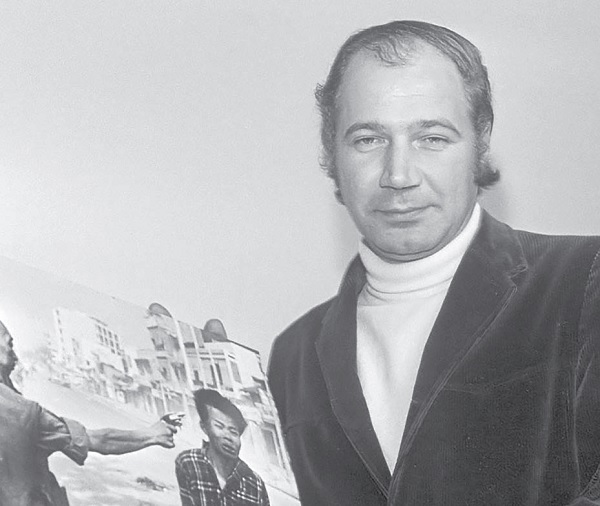What do you see?

Photos freeze history, but what about the facts?
"Have you seen this black and white photo?"
One man holds a pistol and points it at another man's head.
The victim was thin, wearing a plaid shirt, and his hands were tied behind his back. His face was distorted whether from fear or sadness.
This black and white photo allowed many people to see the horror and cruelty of war, the life and death under the barrel of a gun, and the confrontation between the strength and weakness of the perpetrators and the victims.
This photo titled "Saigon Execution" was taken by Associated Press war correspondent Eddie Adams.
On January 30, 1968, North Vietnam launched the largest ground attack on South Vietnam since the war began. Taking advantage of the lack of preparedness of the military and civilians during the New Year period, North Vietnam launched street fighting in more than 100 towns at the same time.
After a day and night of fierce fighting, South Vietnamese and American soldiers pushed back the North Vietnamese. This wave of "New Year attacks" resulted in serious casualties. In addition to Vietnamese civilians and military and political personnel who have not yet been included in the statistics, as many as 2,500 US military personnel were killed. Even the embassy was raided, and five American personnel were killed.
Two days later, Viet Cong captain Nguyen Van Lien was captured by South Vietnamese police chief Nguyen Ngoc Luan. This thin-looking guerrilla leader killed more than thirty South Vietnamese military officers and government officials, including General Nguyen Ngoc Luan's friend and colleague Nguyen Duan. After Nguyen Van Lien beheaded Nguyen Duan, he shot his wife, six children, and his 80-year-old mother with machine guns.
Ruan Wenlian was led to Ruan Yuluan with his hands tied behind his back. Ruan Yuluan raised his pistol and pointed it at his head. The accompanying reporter Adams also raised his camera...
Click! The shutter was pressed, followed by a deafening gunshot.
Adams did not expect that he would record the last moments of Ruan Wenlian's life.
"At the time I thought he was just going to threaten or intimidate this person," Adams said.
A photo summarizes the past and captures the present; the unfinished words stir up the emotions hidden in the depths. But a photo also cuts off the cause and effect, selectively freezing and preserving a certain "moment." A picture that is decontextualized is very likely to fail to represent the entire truth, or it may distort or hide the facts.
Even, reverse the ending of the story.

▲The award-winning classic photo freezes history, but does it present all the facts? The picture shows Adams holding the award-winning photo of "Execution in Saigon". (Image Source:https://en.wikipedia.org/wiki/Eddie_Adams_(photographer)#/media/File:Eddie_Adams_(1969).jpg
The police shot a handcuffed prisoner in civilian clothes on the street without trial - a photo that appeared on the front pages of major newspapers in the United States, on television and on protest posters.
The United States actually supports the government behind this police officer!
This horrifying photo caused many people to question: "Are Americans considered 'good guys' in this war?" "Is what our soldiers are participating in a just war?"
Who are the good guys and the bad guys? What is good and evil? Who draws the line between justice and injustice? Is it the US military and the South Vietnamese government that suffered heavy casualties? The North Vietnamese army that eventually seized power? Innocent civilians ravaged by war? Americans reading newspapers at the breakfast table across the Pacific Ocean? Or us looking at this black and white photo many years later?
"Saigon Execution" set off a huge wave of anti-war public opinion in American society at that time. To this day, most Americans still give a negative evaluation to the Vietnam War; they regard the dispatch of troops as a wrong decision and a page of historical shame.
During the Vietnam War, soldiers killed people with bullets, and politicians killed people with policies. But no one has stirred up waves like Ruan Yuluan, which is still stirring in people's minds many years later.
Nguyen Ngoc Luan explained that his actions were not illegal during the war; he carried out justice on the spot and avenged his colleagues and their families. He later immigrated to the United States and opened a small restaurant to make a living, but his notoriety made the business bleak and unsustainable. He could not tear off the labels of "executioner" and "murderer" for the rest of his life.
Adams's photo is considered a classic shot that changed history. He won the Pulitzer Prize for this photo, and people praised him for his famous saying: "Photography is a powerful weapon." But what really bothered him was: "In that photo, two people died. . The commander killed the Vietcong; and I killed the commander with my camera."
Information is easy to obtain on the Internet, but where is the truth?
In the keyboard era of self-media, countless photos are floating around the Internet and sent to all over the world with one swipe of a finger. Nicholas Mirzoeff, an art historian at New York University, said in his book "An Introduction to Visual Culture": "Seeing is not necessarily true, but is an 'interpretation'."
A picture is worth a thousand words. Every move of an admired celebrity or a hated president is captured in the photo, deepening the viewer’s love and hatred for them, and indirectly fueling support and opposition to events or policies or laws. Are there lies in these silent words? Is there any bias? Are there any elaborate pretensions? Are there any unintentional mistakes?
Postmodernism emphasizes "multiple viewpoints and individual expressions"; the narrative voice in the Internet age is like a hundred birds singing together. It further transforms sound into images, pouring into the eyes continuously, seeping into the soil of thought, and breeding the seeds of ideology. The Internet age was once regarded as a new era in history, expanding the territory of knowledge. However, the popularity of the Internet has invisibly weakened people's ability to trace their origins and restore facts.

▲Postmodernism emphasizes "multiple viewpoints and individual expressions"; the narrative voice in the Internet age is like a hundred birds singing together. It further transforms sound into images, pouring into the eyes continuously, seeping into the soil of thought, and breeding the seeds of ideology.
"Truth" is not becoming more accessible. "Information" is easy to obtain, but it turns "belief" into a luxury product. A certain video or picture that everyone can see not only fails to restore the facts, but also fragments existing experiences and inferences.
Even a casual glance at the picture can be deeply imprinted in the heart. Constant "replay" triggers various emotional reactions and even leads the mind to dark places. The Psalm says: "Please help me turn my eyes away from falsehood, and ask me to live in Your way." "Living in the way" means carrying life with faith, immersing in God's words, and transforming the way we look at the world. When we admire someone, our eyes will naturally be fixated on that person, and there will be no room for other secondary people and things - who are we focusing on? Who is the treasure in your eyes?
In the Internet age, hundreds of schools of thought contend, but what about originality?
The Internet spreads quickly, making it easy for people to reprint and quote various information posts in large quantities. Unconsciously, second-hand processed pictures and texts have become the "staple food" for reading and absorption, while we ourselves have gradually lost the ability to be "original". If you want to convey your stance, just repost ready-made works. And the hidden crisis behind this is: Do we not only express our thoughts through the information compiled by others, but also become the mouthpiece of other people's thoughts in disguise?
If you neglect the cultivation of "originality" and just watch with a cold eye, you will allow the forces that conflict with the truth and belief to flood the Internet media and social platforms with "good articles" and "beautiful pictures" that are perceptual, rational, and spiritual, but you will not continue to do so. There is a lack of material for "reprinting", so how can we provide readers of this generation, those who are unfamiliar with, or even resistant to, the truth, with a medium to come into contact with faith?
“We preach Him, admonishing everyone and teaching everyone with all wisdom.” (Refer to Colossians 1:28) Do we have creativity, new ideas, and the ability to create good words and images to proclaim the good news to the world? ? Are you still passively receiving information, just content to be an "audience"?
The 11th-century theologian Anselm advocated "I believe, therefore I can understand." He believed that knowledge and faith in God are the basis for people to understand the principles and laws of the operation of all things. What do you see in this world? What do you want the world to see? Facing the overwhelming images and sounds of the times, can we have a heart to distinguish right from wrong? Are you ready to post and tell the story of truth to this generation?
Zien, co-worker of "Genesis Literary Training Bookstore". I wrote compositions when I was young, and articles when I grew up. I used to write for myself, but now I give the pen to God. Cooking words to quench hunger cannot bring real spiritual satiety, but I would like to contribute five loaves and two fishes and bake word cookies to "appetite" readers, and then be willing to come into contact with the truth of faith and taste the taste of the Lord's grace.
